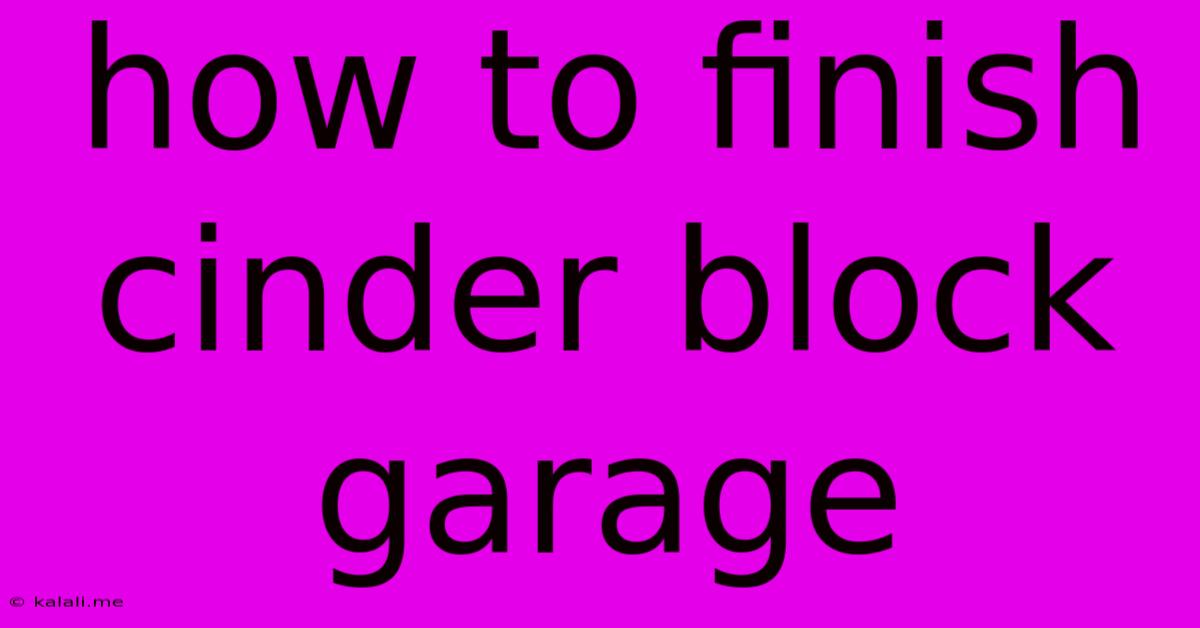How To Finish Cinder Block Garage
Kalali
Jun 10, 2025 · 4 min read

Table of Contents
How to Finish a Cinder Block Garage: A Step-by-Step Guide
Finishing a cinder block garage transforms a cold, unfinished space into a functional and usable area. Whether you plan to use it as a workshop, storage space, or even a home gym, this guide provides a comprehensive step-by-step process to achieve a professional-looking result. This includes advice on insulation, drywall, flooring, and electrical work, ensuring your finished garage is both aesthetically pleasing and practical. This detailed approach will help you navigate the project, regardless of your DIY experience level.
Step 1: Planning and Preparation – Laying the Foundation for Success
Before you even pick up a tool, meticulous planning is crucial. This stage significantly impacts the overall outcome and efficiency of your project. Consider these key aspects:
- Budget: Establish a realistic budget encompassing all materials, tools, and potential unforeseen expenses.
- Design: Decide on the intended use of your garage. This dictates the necessary features, such as shelving, workbench space, or extra electrical outlets. Consider the overall aesthetic you're aiming for. Sketch a simple plan to visualize the layout.
- Permits: Check with your local building department regarding necessary permits. This is a critical step to avoid potential legal issues down the line.
- Materials: Create a comprehensive list of all required materials, including insulation, drywall, flooring, paint, electrical components, and any specialized tools you might need. Purchasing everything upfront saves time and potential delays.
Step 2: Insulation – Creating a Comfortable and Energy-Efficient Space
Insulating your cinder block garage is vital for temperature regulation and energy efficiency. Several options exist:
- Rigid Foam Insulation: This is a popular choice due to its ease of installation and high R-value. It's affixed directly to the cinder block walls.
- Spray Foam Insulation: This provides a seamless, airtight seal, minimizing air leaks and maximizing energy efficiency. However, it requires professional installation.
- Fiberglass Batts: While less effective than rigid foam or spray foam, fiberglass batts are a more budget-friendly option. They're installed between the studs after framing.
Remember to also insulate the garage door and ceiling for optimal thermal performance.
Step 3: Framing and Drywall – Building the Structure and Enhancing Aesthetics
Once insulated, frame the walls using standard wood studs. This provides a solid surface for attaching drywall. Follow these steps:
- Install Studs: Attach the studs to the cinder block walls using appropriate fasteners. Ensure proper spacing for drywall installation.
- Install Drywall: Attach the drywall to the studs using drywall screws. Tape and mud the seams for a smooth, seamless finish. Prime and paint the drywall for a clean, professional look.
Consider adding vapor barrier behind the drywall to further enhance insulation and prevent moisture damage.
Step 4: Flooring – Choosing the Right Surface for Your Needs
The choice of flooring depends heavily on the intended use of your garage.
- Epoxy Flooring: This is a durable and easy-to-clean option, ideal for workshops or areas prone to spills.
- Concrete Flooring: A cost-effective choice, but may require sealing to prevent dust and staining.
- Vinyl Flooring: A relatively inexpensive and water-resistant option, suitable for various garage uses.
Proper preparation of the concrete subfloor is critical before installing any type of flooring.
Step 5: Electrical Work – Ensuring Adequate Power and Safety
Adding electrical outlets and lighting is essential for functionality and safety. Unless you're experienced with electrical work, hiring a qualified electrician is recommended.
- Wiring: Ensure proper wiring and grounding according to local electrical codes.
- Outlets: Install sufficient outlets to power tools and equipment.
- Lighting: Adequate lighting is vital for visibility and safety. Consider installing both overhead and task lighting.
Step 6: Finishing Touches – Adding the Personal Details
The final steps involve adding the finishing touches that personalize your space.
- Painting: Choose a paint suitable for garage environments, considering durability and moisture resistance.
- Shelving and Storage: Install shelving and storage solutions to maximize space and organization.
- Organization: Keep tools and equipment organized and readily accessible.
Finishing a cinder block garage is a rewarding project that enhances both the functionality and value of your property. By following these steps carefully and prioritizing safety, you can create a space you'll enjoy for years to come. Remember to always consult local building codes and consider seeking professional help when needed.
Latest Posts
Latest Posts
-
Excel Test Questions And Answers Pdf
Jun 12, 2025
-
Which One Of The Following Statements Is Not True
Jun 12, 2025
-
Which Statement Is Not True About Bacteria
Jun 12, 2025
-
Words With O I In Them
Jun 12, 2025
-
Very Exciting Can Be New Country Travelling To A
Jun 12, 2025
Related Post
Thank you for visiting our website which covers about How To Finish Cinder Block Garage . We hope the information provided has been useful to you. Feel free to contact us if you have any questions or need further assistance. See you next time and don't miss to bookmark.